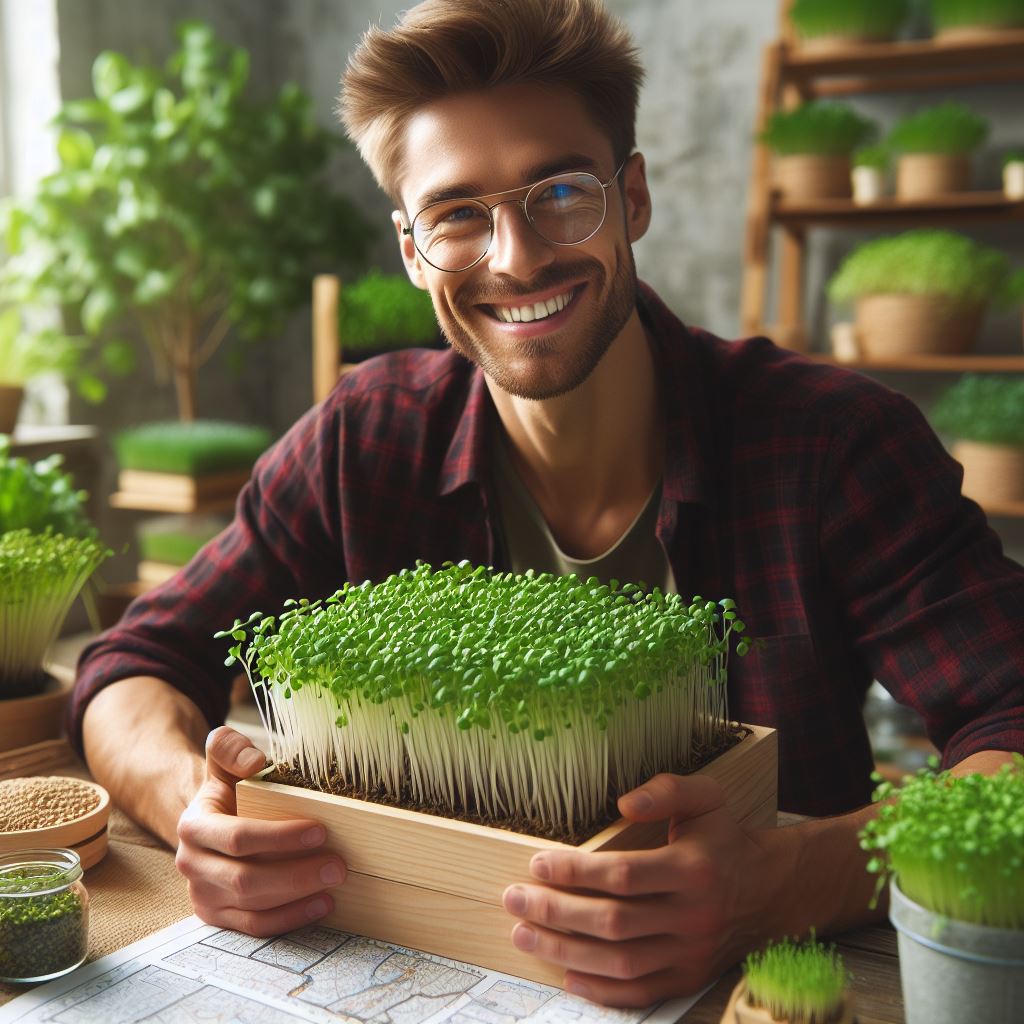Introduction
Mushroom cultivation is the practice of growing mushrooms for consumption or medicinal purposes.
It has gained popularity due to its various benefits. In small gardens, mushroom cultivation has proven to be valuable for several reasons.
This blog post aims to provide a comprehensive guide for those interested in cultivating mushrooms in limited spaces.
Mushrooms are not only delicious and versatile in cooking, but they also offer numerous health benefits.
They are a great source of protein, fiber, vitamins, and minerals.
Additionally, certain varieties of mushrooms have medicinal properties and can boost the immune system, regulate blood sugar levels, and improve digestion.
For small gardens, mushroom cultivation is particularly advantageous due to its space-saving nature.
Unlike traditional vegetable gardens that require ample space, mushrooms can be grown in containers, on shelves, or even indoors.
This makes it an ideal option for those with limited garden space.
The purpose of this blog post is to provide detailed instructions, tips, and techniques for successfully cultivating mushrooms in small garden settings.
It will cover various aspects of mushroom cultivation, including selecting the right mushroom species, preparing the growing substrate, maintaining the optimal growing conditions, and harvesting the mushrooms.
By following the guidelines provided, readers will be able to start their own mushroom cultivation projects, regardless of the size of their gardens.
With the right knowledge and techniques, anyone can experience the joy and satisfaction of growing their own mushrooms at home.
Stay tuned for the upcoming sections, where we will dive deeper into each aspect of mushroom cultivation for small gardens.
Get ready to embark on an exciting journey into the world of mushroom cultivation!
Benefits of Mushroom Cultivation
Mushroom cultivation for small gardens has numerous benefits that make it a worthwhile endeavor.
Not only do mushrooms offer significant nutritional value, but they also possess various medicinal properties.
Additionally, mushroom cultivation is environmentally beneficial. Let’s explore these advantages in detail.
Nutritional value of mushrooms
One of the significant benefits of mushroom cultivation is the nutritional value that mushrooms offer.
Despite being low in calories, mushrooms are packed with essential nutrients like vitamins, minerals, and fiber.
They are an excellent source of B vitamins, such as riboflavin, niacin, and pantothenic acid.
Additionally, mushrooms contain important minerals like selenium, potassium, and copper.
Medicinal properties of mushrooms
Another compelling aspect of mushroom cultivation is the medicinal properties associated with mushrooms.
Some species, like reishi and shiitake, have been used in traditional medicine for centuries.
These mushrooms are known for their immune-boosting properties, and studies suggest that they may help reduce inflammation, lower blood pressure, and support heart health.
The unique compounds found in mushrooms, such as beta-glucans and antioxidants, contribute to their medicinal benefits.
Environmental benefits of mushroom cultivation
In addition to their nutritional and medicinal qualities, mushroom cultivation has significant environmental benefits.
Firstly, growing mushrooms requires minimal space, making it suitable for small gardens.
Unlike traditional gardening, mushroom cultivation does not rely heavily on soil and sunlight.
Instead, mushrooms can be grown indoors or in shaded areas, using substrates like sawdust, wood chips, or even coffee grounds.
This reduces the need for vast agricultural land, making mushroom cultivation a sustainable option.
Furthermore, mushrooms play a crucial role in ecosystem preservation.
They are decomposers that break down organic matter, such as dead trees and fallen leaves, into nutrients for other plants.
This process helps maintain soil health and contributes to the overall balance of ecosystems.
By cultivating mushrooms, gardeners actively participate in nutrient cycling, promoting a sustainable and eco-friendly gardening practice.
In terms of gardening logistics, mushroom cultivation is relatively low-maintenance.
Compared to traditional crops, mushrooms require less water and do not attract pests or diseases easily.
This makes them an ideal choice for beginners or gardeners with limited time and resources.
With proper care and attention, a small mushroom garden can yield a plentiful harvest within a relatively short period.
Mushroom offers a creative outlet for gardeners
Besides the practical advantages, mushroom cultivation also offers a creative outlet for gardeners.
The unique shapes, colors, and textures of various mushroom species can add visual interest and diversity to a garden.
Whether grown indoors or outdoors, mushrooms can be an exciting addition to any gardening project, allowing for experimentation and exploration of different cultivation methods and species.
Basically, mushroom cultivation for small gardens provides multiple benefits that make it an attractive option for gardeners.
The nutritional value and medicinal properties of mushrooms offer immense health benefits.
Additionally, mushroom cultivation is environmentally friendly, contributing to ecosystem preservation and sustainable gardening practices.
With its low-maintenance requirements and creative possibilities, mushroom cultivation has much to offer for both experienced and novice gardeners.
So why not consider embarking on a mushroom cultivation journey and reap the rewards both for your well-being and the environment.
Choosing the Right Mushroom Species
Mushroom cultivation is gaining popularity among small gardeners who want to diversify their harvest.
However, selecting the right mushroom species can be overwhelming for a beginner.
In this section, we will explore different types of mushrooms suitable for small gardens and factors to consider when making your selection.
Transform Your Agribusiness
Unlock your farm's potential with expert advice tailored to your needs. Get actionable steps that drive real results.
Get StartedDifferent types of mushrooms suitable for small gardens
- Button mushrooms (Agaricus bisporus): These versatile mushrooms are the most commonly cultivated species worldwide. They have a mild flavor and are easy to grow, making them perfect for beginners.
- Oyster mushrooms (Pleurotus spp.): Oysters mushrooms come in various colors and have a delicate taste. They grow well on a wide range of substrates, including straw, sawdust, and coffee grounds, making them suitable for small gardens.
- Shiitake mushrooms (Lentinula edodes): Originating from Asia, shiitake mushrooms are known for their rich and smoky flavor. They require specialized growing conditions and are more suitable for experienced gardeners.
Factors to consider when selecting mushroom species
- Growing conditions: Different mushrooms have specific temperature, humidity, and light requirements. Consider your garden’s climate and available resources before choosing a species.
- Yield and crop cycle: Some mushroom species have a faster growth and higher yield than others. If you want a quick harvest, opt for species like oyster mushrooms.
- Personal preference: Consider the taste, texture, and culinary uses of the mushrooms you are selecting. Ensure that you enjoy consuming the species you choose to cultivate.
Popular mushroom species for beginners
- White Button mushrooms: These are excellent for beginners due to their ease of cultivation and mild flavor. They can be grown in compost or straw-based substrates.
- Blue Oyster mushrooms: These vibrant mushrooms are ideal for beginners as they have a fast growth cycle and can fruit multiple times a year.
- Lion’s Mane mushrooms: Known for their unique appearance and taste, Lion’s Mane mushrooms are relatively easy to grow and have a delicate seafood-like flavor.
- King Stropharia mushrooms: Also known as wine cap mushrooms, these species are adaptable to different growing conditions and have a robust and nutty flavor.
In essence, choosing the right mushroom species for your small garden is crucial for a successful harvest.
Consider factors such as growing conditions, yield, and personal preference when making your selection.
Start with beginner-friendly species like button mushrooms or oyster mushrooms, and once you gain more experience, you can venture into growing more specialized varieties.
Happy mushroom cultivation!
Read: Urban Oasis: 5 Steps to Perfect Container Gardens
Setting Up the Growing Area
When it comes to mushroom cultivation for small gardens, one of the first decisions to make is whether to grow them indoors or outdoors.
Both options have their benefits and considerations.
Indoor cultivation offers several advantages. It allows for year-round growing, regardless of external climate conditions.
Additionally, indoor cultivation provides more control over environmental factors such as temperature, humidity, and light.
This control can result in more consistent and successful mushroom growth.
On the other hand, outdoor cultivation has its own merits.
For one, it requires less equipment and setup costs compared to indoor cultivation.
Furthermore, outdoor growing can offer a more natural and diverse environment for mushrooms, leading to potentially unique flavors and characteristics.
Once you have decided on the cultivation method, the next step is selecting a suitable location for your mushroom beds.
Whether indoor or outdoor, the chosen area should meet specific criteria.
For indoor growing, find a space that provides easy access and sufficient room for your mushroom beds, shelves, and other equipment.
Ensure proper ventilation to maintain fresh air circulation and prevent the buildup of excessive moisture.
For outdoor cultivation, look for a spot that receives shade during the hottest parts of the day.
Choose an area away from trees or tall plants that could block sunlight.
Additionally, consider accessibility for watering, monitoring, and harvesting purposes.
Creating the ideal growing conditions for mushrooms
Creating the ideal growing conditions for mushrooms is essential to maximize your yield. Here are some key factors to consider:
- Temperature: Most mushroom varieties thrive at temperatures between 55-65°F (13-18°C). Invest in a thermometer to monitor and maintain optimal temperature levels consistently.
- Humidity: Mushrooms prefer a humid environment. Maintain a relative humidity of around 80-90% to foster growth. Regularly misting the growing area can help achieve and maintain adequate humidity levels.
- Light: While mushrooms don’t require direct sunlight, they do benefit from indirect or diffused light. Position your growing area near a well-lit window or install artificial lighting, such as fluorescent or LED bulbs.
- Ventilation: Proper air circulation is crucial for preventing the growth of mold and ensuring healthy mushroom development. Use fans or open windows to promote fresh air exchange within the cultivation area.
- Substrate Preparation: Different mushroom species have varying substrate requirements. Research the specific needs of your chosen variety and prepare the substrate accordingly. Common substrates include straw, sawdust, wood chips, and compost.
- Watering: Maintaining proper moisture levels is vital for mushroom growth. Use a spray bottle or misting system to water the substrate regularly. Avoid overwatering, as excess moisture can lead to mold or bacteria growth.
- Sterility: Maintaining a sterile growing environment is essential to prevent contamination. Use clean equipment, sanitize the growing area regularly, and follow proper hygiene practices when handling mushrooms or their substrates.
By carefully selecting the cultivation method, choosing an appropriate location, and creating optimal growing conditions, you can successfully cultivate mushrooms in your small garden.
Enjoy the satisfaction of harvesting fresh and flavorful mushrooms right at home.
Read: Eco-Friendly Gardening: Sustainable Practices
Preparing the Substrate
Types of substrates for different mushroom species
- Compost: Ideal for growing button mushrooms, oyster mushrooms, and shiitake mushrooms.
- Straw: Suitable for growing oyster mushrooms and shiitake mushrooms.
- Wood chips: Perfect for cultivating shiitake mushrooms and lion’s mane mushrooms.
- Sawdust: Best for growing oyster mushrooms, shiitake mushrooms, and lion’s mane mushrooms.
A step-by-step guide to preparing the mushroom substrate
- Select the appropriate substrate based on the mushroom species you want to cultivate.
- Ensure the substrate is clean and free from any contaminants.
- Break down the substrate into small pieces, using a shredder or by hand.
- If using compost, mix it with a nitrogen source like poultry manure or soybean meal.
- For straw-based substrates, soak the straw in water for a few hours to increase its moisture content.
- If using wood chips or sawdust, sterilize them by boiling or autoclaving to kill any competing organisms.
- Add mushroom spawn to the substrate. The spawn contains mycelium that will grow and colonize the substrate.
- Mix the spawn thoroughly with the substrate to ensure even distribution.
- Pack the substrate mixture into containers or bags, leaving enough space for the mushrooms to grow.
- Close the containers or bags, ensuring there is some air exchange possible.
- Store the containers or bags in a dark, cool, and humid location suitable for mushroom growth.
Ensuring proper sterilization and moisture content
- Sterilization is crucial to eliminate any competing organisms that could hinder mushroom growth.
- Properly sterilize the substrate by boiling, pressure cooking, or using an autoclave.
- Maintain a moisture content of around 60-70% in the substrate. Too much or too little can affect growth.
- Use a moisture meter to check the substrate’s moisture levels regularly throughout the cultivation process.
- If the substrate becomes too dry, mist it lightly with water to maintain the desired moisture content.
- Avoid overwatering the substrate, as excess water can lead to mold or bacterial growth.
By following these guidelines, you can successfully prepare the substrate for mushroom cultivation in small gardens.
Remember to choose the appropriate substrate for the desired mushroom species, sterilize it properly, and maintain the ideal moisture content for optimal growth.
Happy mushroom cultivation!
Read: Balcony Farming: Urban Organic Strategies

Inoculation and Spawning
Types of mushroom spawn and their uses
Inoculation and spawning are crucial steps in mushroom cultivation for small gardens.
The choice of spawn and the method of inoculation greatly influence the success of the process and the yield of mushrooms.
Understanding the different types of mushroom spawn and their uses is essential for selecting the suitable option for your chosen species.
Grain spawn is a versatile option that works well for many mushroom varieties.
It can be easily inoculated using liquid culture or agar wedges, making it convenient for small-scale cultivators.
Sawdust spawn, on the other hand, is ideal for species like oyster mushrooms, as they require a lignin-rich substrate.
By mixing hardwood sawdust with mushroom mycelium, you can create an environment conducive to colonization.
If you plan to cultivate mushrooms on logs or stumps, plug spawn is the recommended choice.
By drilling holes and inserting wooden plugs infused with mycelium, you can initiate colonization.
Seal the holes with wax to provide a barrier against contamination while allowing mycelium to spread.
Liquid spawn is particularly useful for substrates like straw or wood chips.
By injecting the liquid mycelium using a syringe or sprayer, you facilitate rapid and efficient colonization.
Tips for successful spawning
To ensure successful spawning, it is crucial to maintain sterile conditions during inoculation.
This prevents any competing organisms from taking over the substrate and potentially ruining the cultivation process.
Even distribution of spawn throughout the substrate promotes uniform colonization and faster growth.
Proper moisture levels and temperature are vital for mycelium development.
Regular monitoring of the colonization progress allows for prompt action if any issues arise.
Protecting the spawn from extreme temperatures, sunlight, and pests further increases the chances of successful cultivation.
By following these tips and using high-quality spawn from reputable suppliers, you can increase the likelihood of a successful mushroom cultivation endeavor.
Inoculation and spawning lay the foundation for healthy mycelium growth, which ultimately leads to bountiful harvests in small gardens.
Read: Pollinator-Friendly Gardening: Bees & More
Caring for Mushroom Beds
Mushrooms can be a nutritious and delicious addition to any small garden.
However, to ensure a successful harvest, it is important to properly care for your mushroom beds.
Here are some essential tips:
Proper Watering Techniques
- Water the mushroom beds regularly to maintain the necessary moisture level.
- Use a gentle misting technique to avoid disturbing the delicate mushroom caps.
- Avoid overwatering, as excessive moisture can lead to fungal diseases and mold growth.
Maintaining Appropriate Humidity and Temperature
- Mushrooms thrive in specific humidity and temperature ranges, which vary depending on the mushroom species.
- Use a hygrometer to monitor humidity levels in the growing area, aiming for 70-90% humidity.
- Maintain a stable temperature between 50-70°F (10-21°C), as fluctuations can stress the mushrooms.
Methods to Prevent Contamination and Pests
- Maintain good hygiene by regularly cleaning tools and containers used for mushroom cultivation.
- Sterilize the growing medium and substrate before use to reduce the risk of contamination.
- Place a layer of clean, sterilized soil or casing material on top of the mushroom beds to act as a barrier against pests and contaminants.
- Inspect the beds regularly for signs of pests, such as gnats or mites, and take appropriate measures to eliminate them.
Proper Harvesting Techniques
- Harvest mushrooms when they reach the desired size but before the caps fully expand and release spores.
- Twist or gently cut the mushroom stems close to the substrate to avoid damaging the mycelium.
- Harvest mushrooms in batches, allowing smaller ones to continue growing for subsequent harvests.
- Properly dispose of any mushroom waste to prevent the spread of diseases or pests.
Regular Monitoring and Maintenance
- Check the mushroom beds daily for any changes in moisture levels, temperature, or signs of contamination.
- Adjust the watering schedule and environmental conditions accordingly to ensure optimal growth.
- Remove any dead or decaying mushrooms promptly to prevent the spread of diseases.
- Replace the growing medium periodically to maintain nutrient levels and prevent the buildup of contaminants.
In general, caring for mushroom beds in small gardens requires attention to detail and proper maintenance.
By following the tips mentioned above, you can create a healthy and productive environment for your mushrooms to thrive.
Happy mushroom cultivation!
Harvesting and Storing Mushrooms
Identifying the right time to harvest
- Observe the mushroom caps closely to determine the ideal harvesting time.
- Look for fully mature mushrooms with opened caps and exposed gills.
- Avoid harvesting mushrooms that have started to show signs of deterioration or discoloration.
- Regularly check the growth rate of the mushrooms to ensure timely harvesting.
Harvesting techniques for different mushroom species
- For button mushrooms, twist the cap gently and apply slight pressure to detach them from the substrate.
- Oyster mushrooms can be picked by gently pulling them upwards, making sure to remove the entire cluster.
- Shiitake mushrooms should be harvested when the caps are flat and before the edges start to curl.
- Lion’s mane mushrooms can be cut at the base using a sharp knife to preserve the mycelium.
- Morel mushrooms should be carefully plucked or cut at the base to avoid damaging the delicate caps.
Proper storage and preservation methods
- Clean the harvested mushrooms by gently brushing off any dirt or debris using a soft brush or cloth.
- Avoid washing the mushrooms as they are highly absorbent and may become mushy.
- Store the mushrooms in a breathable container such as a paper bag or a loosely covered glass container.
- Place a damp cloth or paper towel in the container to maintain moisture without causing sogginess.
- Store the mushrooms in the refrigerator, preferably in the crisper drawer, to maintain cool temperatures.
- Avoid keeping mushrooms near foods with strong odors as they can easily absorb these smells.
- Use the mushrooms within a few days to ensure optimal freshness and flavor.
- To extend the shelf life, consider drying or preserving the mushrooms by dehydrating or canning them.
Properly harvested and stored mushrooms can provide a bountiful supply for delicious meals throughout the year.
Follow these tips to enjoy the rewards of your small garden mushroom cultivation.
Showcase Your Farming Business
Publish your professional farming services profile on our blog for a one-time fee of $200 and reach a dedicated audience of farmers and agribusiness owners.
Publish Your ProfileConclusion
In this blog post, we covered the key points of mushroom cultivation for small gardens.
We learned about the importance of choosing the right mushroom varieties, preparing the growing medium, and maintaining ideal growing conditions.
By following the tips and techniques discussed, readers can successfully cultivate mushrooms in their own small gardens.
Not only is mushroom cultivation a rewarding and enjoyable hobby, but it also provides a fresh and nutritious food source.
For those interested in exploring further, here are some additional resources and references:
- “Growing Gourmet and Medicinal Mushrooms” by Paul Stamets – this book provides in-depth guidance on mushroom cultivation techniques.
- Mushroom cultivation kits – these ready-made kits include everything you need to get started, making it even easier for beginners.
- Online communities and forums – connecting with experienced mushroom growers can provide valuable insights and support.
- Local gardening clubs and workshops – attending such events can offer hands-on learning opportunities and networking with like-minded individuals.
So, don’t hesitate to start your own mushroom cultivation journey in your small garden.
With some patience, dedication, and the right information, you can enjoy the satisfaction of growing your own delicious mushrooms at home.
Happy gardening!




